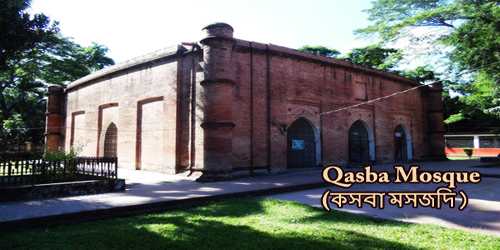Qasba Mosque (Bengali: কসবা মসজিদ) is an ancient nine-domed mosque and archaeological site, which derives its name from the village Qasba under Gurnadi Upazila in Barisal district, is located a few yards away from the Barisal-Faridpur highway. It is very similar to the Nine Dome Mosque in Bagerhat. This is a typical multi-domed square structure built entirely of well-burnt red bricks, save for the four stone pillars that support the domes on the roof. The walls are very massive with a thickness of 2.13m while the circular corner towers rise only up to the roof level. The mosque has three archways, on each of the north, south, and east sides. Of the three arches, the central one is the largest. It is to be noted here that in the north and south walls only the central archway is now open, while the flanking ones have been closed by brick filling. The three semi-circular mihrab niches inside the qibla wall are kept symmetrically large and small corresponding to the three entrances in the east wall. According to local tradition, it was built by Sabhi Khan in the early 16th century. It is almost the exact replica of the Nine Dome Mosque built by Khan Jahan Ali in Bagerhat and Masjidkur Mosque in Khulna. Though still in use, the mosque is a protected monument by the Department of Archaeology.
The mosque measures 11.68×11.68 meters and the walls are 2.18 meters wide. There are three archways on the east side while there are one arch on each side of the north and south. The arches are decorated with terracotta paintings. It has four stone pillars inside. The domes, nine in total, rest on arches springing from the stone pillars. The four triangular corner spaces, formed by the intersection of arches just below the base of the dome in each bay, are filled with traditional Bengali pendentives. The four corner towers have slightly molded bases and plain tops. The only cornice band of the building is curved in the Bengali fashion. The decorations of the mosque consist only of terracotta depicting diaper, lozenge, scrolls, interlocking patterns, and rosettes. These decorations are now seen in the mihrab niches and the doorway arches. After restoration and repair by the Directorate of Archaeology, the mosque has become one of the best-preserved monuments in Bengal. It is now being used for prayers five times a day. The building is not dated by any inscription. Tradition has it that it was built early in the 16th century by one Sabhi Khan, whose identity is still unknown. But in plan, in measurement, in the arrangement of the interior apartments and the domes on the roof, in the setting of the door openings and the design of the corner towers, the Qasba Mosque appears to be a replica of the nine-dome mosque of khan Jahan at Bagerhat and the masjidkur mosque in Khulna.
















